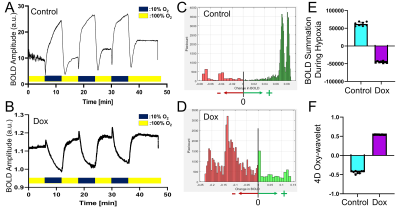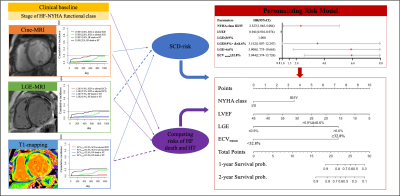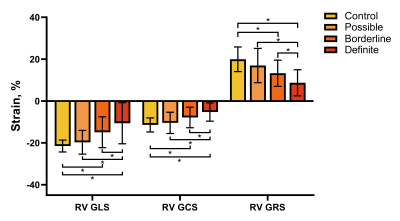Digital Poster
Cardiomyopathy I
ISMRM & ISMRT Annual Meeting & Exhibition • 03-08 June 2023 • Toronto, ON, Canada

| Computer # | |||
|---|---|---|---|
4695. |
101 |
Cardiac energetic deficit in a rat model of Heart Failure with
Preserved Ejection Fraction (HFpEF)
James A Goodman1,
James D Quirk2,
Xia Ge2,
Yao Zhang1,
and Rachel Roth-Flach1
1Pfizer, Inc, Cambridge, MA, United States, 2Washington University in St. Louis, St. Louis, MO, United States Keywords: Cardiomyopathy, Cardiovascular, energetics Cardiac energetics in patients with heart failure with preserved ejection fraction (HFpEF) may serve as a useful biomarker of disease status and therapeutic intervention. To evaluate the potential suitability of this endpoint as a biomarker in preclinical research, we assessed cardiac energetics in the ZSF1 obese rat model of HFpEF and ZSF1 lean control. This preclinical HFpEF model exhibited similar cardiac energetic deficits as do humans with HFpEF, indicating that that the PCr/γATP ratio may be a useful translational biomarker of disease status and intervention. |
|
4696. |
102 |
Probing Mitochondrial Dysfunction in Mouse Hearts with
Doxorubicin-Induced Cardiotoxicity Using Ungated 4D Oxy-wavelet
MRI
Devin Raine Everaldo Cortes1,2,3,
Margaret C. Stapleton2,3,
Kristina E. Schwab4,5,
Noah W. Coulson2,3,
Elizabeth Mazzella2,3,6,
Dalton R West2,3,
Thomas Becker-Szurszewski3,7,
Sean Hartwick3,4,
Anthony G. Christodoulou8,
and Yijen L Wu1,2,3,7
1Department of Bioengineering, Swanson School of Engineering, University of Pittsburgh, Pittsburgh, PA, United States, 2Department of Developmental Biology, School of Medicine, University of Pittsburgh, Pittsburgh, PA, United States, 3Rangos Research Center Small Animal Imaging Core, Children's Hospital of Pittsburgh of UPMC, Pittsburgh, PA, United States, 4Rangos Research Center Animal Imaging Core, Children's Hospital of Pittsburgh of UPMC, Pittsburgh, PA, United States, 5Department of Pediatrics, University of Pittsburgh, School of Medicine, Pittsburgh, PA, United States, 6Department of Chemistry, Dietrich School of Arts and Sciences, University of Pittsburgh, Pittsburgh, PA, United States, 7Department of Pediatrics, School of Medicine, University of Pittsburgh, Pittsburgh, PA, United States, 8Biomedical Imaging Research Institue, Cedars-Sinai Medical Center, Los Angeles, CA, United States Keywords: Heart, Toxicity, 4D fMRI, Doxorubicin, cardiomyopathy Cardiomyopathy caused by anti-cancer anthracyclines, such as Doxorubicin (Dox), is one major cause for long-term morbidity and mortality among cancer survivors. Patients can develop cardiomyopathy leading to heart failure decades after successful cancer treatment with Dox. There is an urgent need for early detection of sub-clinical pathogenesis of Dox-induced cardiotoxicity for early intervention before irreversible cardiac tissue damage occurs. Cellular mechanistic investigations showed that mitochondrial dysfunctions are central to the Dox-induced cardiotoxicity. We have developed a time-and-motion-resolved 4D Oxy-wavelet MRI capable of detecting early Dox-induced mitochondrial dysfunction in the heart before irreversible myocardial damage occurred. |
|
4697. |
103 |
Cine T2 mapping reveals cardiac cycle-dependent T2 variability
in cardiomyopathy
Michinobu Nagao1,
Masami Yoneyama2,
Yasuhiro Goto1,
Isao Shiina1,
Kazuo Kodaira1,
Mana Kato1,
Yasutomo Katsumata2,
Yurie Shirai1,
Atsushi Yamamoto1,
Akiko Sakai1,
Risako Nakao1,
and Shuji Sakai1
1Tokyo Women's Medical University, Tokyo, Japan, 2Philips Japan, Tokyo, Japan Keywords: Cardiomyopathy, Inflammation We have successfully developed cardiac cine imaging to project T2 values using T2prep-based T2 mapping with dynamic multiple trigger-delay framework. We have demonstrated that diastolic T2 values on cine T2 mapping are temporarily prolonged in patients with non-ischemic cardiomyopathy and impaired left ventricular function. Cine T2 mapping is a new noninvasive in vivo imaging technique for myocardial edema that provides an effective means of elucidating the pathogenesis of cardiomyopathy. |
|
4698. |
104 |
Cardiac Power to Mass Assessment by MRI in Patients with
Hypertrophic Cardiomyopathy and Normal Ejection Fraction
Li Qing1,
Zhou Zhen1,
Gao Yifeng1,
Ke Jiang2,
and Lei Xu1
1Beijing Anzhen Hospital, Beijing, China, 2Philips Healthcare, Beijing, China, Beijing, China Keywords: Cardiomyopathy, Cardiomyopathy, cardiac power; hypertrophic cardiomyopathy; ejection fraction Cardiac power (CP) output in patients with heart failure has been studied, while its importance in hypertrophic cardiomyopathy (HCM) patients is yet unclear. 99 HCM patients and 65 gender- and age-matched controls with cardiac MR were included in the study. HCM patients showed significantly higher CP (p=0.031) but lowered NCP (p<0.001) than the controls. The correlation analysis of NCP and functional parameters revealed that NCP was inversely correlated with LV mass (R=-0.395, p<0.001) in HCM patients. NCP decreased significantly in HCM patients and may continue to deteriorate with increasing LV mass. |
|
4699. |
105 |
Reverse Remodeling of Left Atrium Assessed by Cardiac MR Feature
Tracking in Hypertrophic Obstructive Cardiomyopathy after Septal
Myectomy
Shujuan Yang1 and
Shihua Zhao1
1Fuwai Hospital, Beijing, China Keywords: Cardiomyopathy, Surgery Eighty-eight patients with hypertrophic obstructive cardiomyopathy(HOCM) who received CMR before and after myectomy were retrospectively studied. Thier Pre- and postmyectomy left atrial (LA) parameters derived from CMR-feature tracking were compared. Patients with HOCM after septal myectomy showed LA reverse remodeling with a reduction in LA size and restoration in LA reservoir and booster function but unchanged LA conduit function. Among volumetric and functional changes, booster function had the greatest improvement postoperatively. Besides, preoperative LAVmin index and ΔLVOT might be potential factors associated with the degree of improvement in εa. |
|
4700. |
106 |
Global Longitudinal Strain Associates with Adverse Outcomes in
Nonischemic Dilated Cardiomyopathy without Myocardial Scar
Xiaorui Xiang1,
Xiuyu Chen1,
and Shihua Zhao1
1Fuwai Hospital and National Center for Cardiovascular Diseases, Beijing, China Keywords: Cardiomyopathy, Cardiomyopathy Despite late gadolinium enhancement (LGE) have already proved a strong association with adverse outcomes in non-ischemic dilated cardiomyopathy (NIDCM) patients, for those who with negative LGE, mortality remains a clinical issue. This study therefore aimed to investigate the prognostic impact of cardiac magnetic resonance (CMR) feature tracking derived strain in NIDCM patients without myocardial scar. |
|
4701. |
107 |
Differential diagnosis for hypertrophic cardiomyopathy and
hypertensive heart disease by layer-specific CMR strain analysis
Ningning Song1,
Weibin Dai1,
Tingting Liu1,
Yueyou Peng1,
Qianyu Hu1,
Kunkun Liu1,
Tianfeng Shi1,
Donglian Du1,
Xiaoqiong Li1,
Yueluan Jiang2,
and Yanfeng Meng1
1Taiyuan Central Hospital of Shanxi Medical University, Taiyuan, China, 2Siemens Healthineers Ltd., Beijing, China Keywords: Heart, Cardiomyopathy This study evaluated the left ventricle (LV) and right ventricle (RV) layer-specific (endocardium=Endo, epicardium=Epi, myocardium=Myo) strain of hypertrophic cardiomyopathy (HCM) and hypertensive heart disease (HHD). We also evaluated the ability of left atrium (LA) to differentiate HCM and HHD. The strain and strain rate were calculated from CMR. The difference of LV between HCM and HHD was endocardium. The difference of RV was free wall epicardium. The difference of LA was LA strain at conduit phase (LAS-cd). Combining the LV global circumferential strain rate of endocardium (GCSR-Endo) and LASR-cd can better differentiate HCM and HHD. |
|
4702. |
108 |
Full cardiac cycle coverage T2* mapping detects early myocardial
changes in hypertrophic cardiomyopathy
Oumaima Laghzali1,2,
Sandra Lehmann1,3,
Joao dos Santos Periquito1,
Andreas Pohlmann1,
Lucie Carrier4,5,
Thoralf Niendorf1,2,6,
Sonia Waiczies1,
and Min-Chi Ku1,2
1Berlin Ultrahigh Field Facility (B.U.F.F), Max Delbrueck Center for Molecular Medicine in the Helmholtz Association, Berlin, Germany, 2DZHK (German Centre for Cardiovascular Research), partner site Berlin, Berlin, Germany, 3Technische Universität Berlin, Berlin, Germany, 4Department of Experimental Pharmacology and Toxicology, University Medical Center Hamburg-Eppendorf, Hamburg, Germany, 5DZHK (German Centre for Cardiovascular Research), partner site Hamburg/Kiel/Lübeck, Hamburg, Germany, 6Experimental and Clinical Research Center, Charite Medical Faculty and the Max Delbrueck Center for Molecular Medicine in the Helmholtz Association, Berlin, Germany Keywords: Cardiomyopathy, Tissue Characterization, Tissue remodeling Most cases of hypertrophic cardiomyopathy (HCM) are detected at a stage when the heart has experienced significant damage. The aim of this study is to detect subtle changes in the myocardium before the appearance of overt symptoms of HCM. We show that myocardial T2* mapping can detect early changes throughout the full heart cycle in a HCM mouse model that represents the human genetic heart disease. This could potentially provide a biomarker for early stages of HCM that might be useful for non-invasive diagnoses. |
|
4703. |
109 |
Heart Failure with Normal Natriuretic Peptide Levels and
Preserved Ejection Fraction: A Prospective Clinical and CMR
study
Jian He1,
Wenjing Yang1,
Kelvin Chow2,
Jing An3,
and Minjie Lu1
1Fuwai hospital, Chinese Academy of Medical Sciences and Peking Union Medical College, Beijing, China, 2Siemens Healthineers, Los Angeles, CA, United States, 3Siemens Shenzhen Magnetic Resonance Ltd., Shenzhen, China Keywords: Heart, Heart The predisposed HFpEF has relatively unique clinical and CMR features, which indicates it may be an important subtype or precursor of HFpEF. However, the specific clinical significance of these features requires further prognostic studies. |
|
4704. |
110 |
CMR-based Personalizing Risk Stratification for Outcomes in
Dilated Cardiomyopathy: A Single-center Prospective Study.
Di Zhou1,
Kelvin Chow2,
Jing An3,
and Minjie Lu1
1Fuwai hospital, Beijing, China, 2Siemens Healthineers SHS AM NAM USA DI MR COLLAB, Los Angeles, CA, United States, 3Siemens Shenzhen Magnetic Resonance Ltd. SHS DI MR R&D SZN DL, Shenzhen, China Keywords: Cardiomyopathy, Cardiomyopathy In this study, we explored individual weight of CMR metrics for predicting short-term outcomes in DCM. ECV fraction performed excellent potential of clinical translation for prognosis in patients with DCM. LGE has better prognostic value than other CMR metrics for SCD and aborted SCD. LV strain may contribute to predict advanced heart failure, which not aid to the risk stratification of SCD. In this way, we developed a risk stratification model based on cardiac MR imaging including NYHA functional class, left ventricular ejection fraction, late gadolinium enhancement, and mean extracellular volume. It may improve clinical assessment and individual decision making. |
|
4705. |
111 |
Right ventricular strain for the diagnosis and prognosis of
arrhythmogenic right ventricular cardiomyopathy
Zhixiang Dong1 and
Shihua Zhao1
1Fuwai Hospital, National Center for Cardiovascular Diseases, State Key Laboratory of Cardiovascular, Beijing, China Keywords: Cardiomyopathy, Quantitative Imaging, arrhythmogenic right ventricular cardiomyopathy To find out the values of strain parameters in the diagnosis and prognosis of arrhythmogenic right ventricular cardiomyopathy (ARVC), 247 patients with initial diagnosis of suspected ARVC were included in this study. Results showed that right ventricular global longitudinal strain (RV GLS) had moderate to high discriminatory power to identify patients with different likelihood of ARVC. Besides, patients with reduced RV GLS had a higher estimated cumulative incidence of combined cardiovascular events. These findings indicate that cardiac magnetic resonance feature tracking could potentially be used as a preferred imaging method in the first visit and follow-up of ARVC. |
|
4706. |
112 |
Fractal Analysis: Left Ventricular Trabecular Complexity Cardiac
MRI Adds Independent Risks for HFpEF in Participants with ESRD
Tian-yi Zhang1,
Peng Wu2,
Lian-Ming Wu3,
and Shan Mou1
1Nephrology, Shanghai Jiaotong University School of Medicine Affiliated Renji Hospital, Shanghai, China, 2Philips Healthcare, Shanghai, China, Shanghai, China, 3Radiology, Shanghai Jiaotong University School of Medicine Affiliated Renji Hospital, Shanghai, China Keywords: Cardiomyopathy, Tissue Characterization The aim of this study was to measure left ventricular (LV) trabecular complexity by fractal dimension (FD) in patients with end-stage renal disease (ESRD), and assess whether FD is an independent risk predictor for heart failure with preserved ejection fraction (HFpEF) in this population. We found that LV mean basal FD was an independent predictor for HFpEF in the multivariate analysis. Adding LV mean basal FD to the baseline model resulted in a higher C-index and significant NRI, indicating better discriminatory ability to HFpEF en ESRD patients. |
|
4707. |
113 |
From Survival to Survivorship: Cardiac MRI and Serum Biomarkers
of Early Detection and Therapy for Doxorubicin-Induced
Cardiotoxicity in Mice
Margaret Caroline Stapleton1,2,
Elizabeth Mazzella1,3,
Noah Coulson1,2,
George Cater4,
Kristina Schwabb5,6,
Sean Hartwick5,6,
Thomas Becker-Szurszewski5,6,
Devin Rain Everaldo Cortes1,2,7,
and Yijen L. Wu1,2
1Department of Developmental Biology, University of Pittsburgh, Pittsburgh, PA, United States, 2Rangos Research Center Animal Imaging Core, Children's Hospital of Pittsburgh, Pittsburgh, PA, United States, 3Department of Chemistry, University of Pittsburgh, Pittsburgh, PA, United States, 4St. Clair Hospital, Pittsburgh, PA, United States, 5Rangos Research Center Animal Imaging Core, Children's Hospital of Pittsburgh PA, Pittsburgh, PA, United States, 6Department of Pediatrics, University of Pittsburgh School of Medicine, Pittsburgh, PA, United States, 7Department of Bioengineering, University of Pittsburgh Swanson School of Engineering, Pittsburgh, PA, United States Keywords: Cardiomyopathy, Toxicity Anthracycline, like Doxorubicin (DOX), induced cardiotoxicity is a major cause of morbidity among childhood cancer survivors. Prior clinical studies diagnose using isolated measures of cardiac function, but by the time cardiotoxicity is detected, irreversible damage has already occurred. We hypothesize that multi-parametric cardiac MRI (CMR), and concurrent treatment with cardioprotective agents is a more sensitive biomarker for early diagnosis of DOX-induced cardiotoxicity. We identified DOX cardiotoxicity by CMR derived LV strain and Luminex biomarker analysis prior to any decrease in EF and SV. Our study suggests multi-parametric CMR with concurrent cardioprotective treatment can be a surrogate endpoint for therapeutic efficacy. |
|
4708. |
114 |
Cardiac PET-MRI to measure cardiac efficiency access Alginate
intramyocardial injections in a porcine heart failure model
Mehrzad Tartibi1,
Uttam Shrestha2,
Youngho Deo3,
Grant Gullberg4,
Christopher T. Nguyen5,
Vahid Ravanfar3,
Qizhi Fang3,
and Randall J. Lee3
1DelBeat, Berkeley, CA, United States, 2University of California San Francisco, San Francisco, CA, United States, 3University of California, San Francisco, San Francisco, CA, United States, 4Lawrence Berkeley National Laboratory, Berkeley, CA, United States, 5Cleveland Clinic, Cleveland, OH, United States Keywords: Cardiomyopathy, Heart, Hear efficiency Nearly 70% of heart attacks (myocardial infarctions, MI) cases lead to a condition known as heart failure (HF), where the left ventricle (LV) remodels. Previous alginate and stem cell intramyocardial injection studies reported mixed outcomes using the LV global volumetric function and local myocardium mechanical response (strains and stresses)1,2. Such measures involve unvalidated assumptions yielding erroneous results3. We conducted a swine HF study treated with a particular alginate intramyocardial injection; however, instead of using the mechanical response, we directly measured the metabolic energy consumed by the myocardium before and after treatment using Positron emission tomography–magnetic resonance images (PET-MRI)4. |
|
4709. |
115 |
The Evaluation of Treatment Effects on Left Ventricular
Structure and Function in Primary Aldosteronism by Cardiac
Magnetic Resonance Imaging
Lu Tang1,
Jens Wetzl2,
Xiaoyue Zhou3,
Yan Ren4,
and Jiayu Sun1
1Department of Radiology, West China Hospital, Sichuan University, Chengdu, China, 2MR Application Predevelopment, Siemens Healthcare GmbH, Erlangen, Germany, 3MR Collaboration, Siemens Healthineers Ltd, Shanghai, China, 4West China Hospital, Sichuan University, Chengdu, China Keywords: Myocardium, Cardiovascular, cardiac magnetic resonance imaging; left ventricle; primary aldosteronism; strain; dysfunction This study used routine cardiac function parameters and strain parameters based on cardiac magnetic resonance imaging to evaluate the effects of specific treatments on left ventricular structure and function in patients with PA. We found that patients with PA had lower LV volumes and myocardial mass, as well as improved circumferential and longitudinal myocardial motion both after adrenalectomy and drug treatment. Specific treatment in patients of PA can not only effectively relieve the clinical symptoms, but also improve left ventricular structure and subclinical dysfunction. |
|
4710. |
116 |
Cardiovascular magnetic resonance findings in Danon disease:A
case series of a big family
Xiaolong Liu1,
Zhanguo Sun1,
Ning Zhai1,
and Xiuzheng Yue2
1Department of Radiology, Affiliated Hospital of Jining Medical University, Jining, China, 2Philips Healthcare (Beijing), Beijing, China Keywords: Heart, Myocardium Heart involvement is the leading cause of death of Danon disease (DD). However, the cardiac magnetic resonance (CMR) features of DD are not well understood. Hence, we present seven DD patients with from the same family with follow-up since 2017. In our cohort, the typically CMR features of DD were left ventricle (LV) hypertrophy, late gadolinium enhancement of LV, diminished strain, and preserved or reduced LV ejection fraction. Late gadolinium enhancement most commonly involves the LV free wall and the right ventricle insertion points. Moreover, these CMR changes in male patients appeared earlier and more significant, and progressed faster. |
|
4711. |
117 |
Entropy as a Novel Predictor of Cardiovascular Events in
Patients with Left Ventricular Noncompaction
Yan Gao1,
Mengxiao Liu2,
Zhiguo Ju3,
and Ximing Wang4
1Department of Radiology, Shandong Provincial Hospital, Shandong University, Jinan, China, 2Siemens Healthineers, Shanghai, China, 3College of Medical Imaging, Shanghai University of Medicine & Health Science, Shanghai, China, 4Department of Radiology, Shandong Provincial Hospital Affiliated to Shandong First Medical University, Jinan, China Keywords: Myocardium, Heart The prognosis of LVNC is remarkably heterogeneous, with heart failure (HF), ventricular arrhythmias (VAs) and systemic embolisms (SEs) being the most frequent cardiovascular complications but no specific recommendations are available at present. In the present study, we aimed to investigate whether LV entropy could efficiently predict major adverse cardiac events (MACEs) in patients with LVNC incremental to established clinical and imaging risk markers. |
|
4712. |
118 |
Subendocardial Involvement as an Underrecognized LGE Subtype
Related to Adverse Outcomes in Hypertrophic Cardiomyopathy
Shujuan Yang1 and
Shihua Zhao1
1Fuwai Hospital, Beijing, China Keywords: Cardiomyopathy, Heart In a retrospective cohort study, 497 consecutive HCM patients with LGE confirmed by cardiac MR were collected. The risk of cardiovascular events increases with per percentage increase in LGE extent in HCM patients with extensive LGE (>15%). While instead of LGE extent, the subendocardium-involved LGE pattern, an underrecognized phenotype in HCM, is related to the adverse outcomes in patients with non-extensive LGE (<15%), especially for heart failure-related outcomes. RVIP LGE is commonly seen in HCM, but this LGE location does not merit a prognostic value. |
|
4713. |
119 |
Endogenous contrast T1ρ CMR: a novel technology for differential
diagnosis between cardiac amyloidosis and hypertrophic
cardiomyopathy
Keyan Wang1,
Jie Zheng2,
Jing An3,
and Jingliang Cheng1
1MRI, The First Affiliated Hospital of Zhengzhou University, Zhengzhou, China, 2Mallinckrodt Institute of Radiology, St. Louis, MO, United States, 3Siemens Healthineer, Shenzhen, China Keywords: Myocardium, Cardiomyopathy This study evaluated a cardiac T1ρdispersion mapping technique, termed as myocardial fibrosis index (mFI), to distinguish cardiac amyloidosis (CA) from hypertrophic cardiomyopathy (HCM). Our data showed that mFI is significantly superior to native T1 and contrasts medium-derived extracellular volume in the differential diagnosis of CA and HCM. |
|
The International Society for Magnetic Resonance in Medicine is accredited by the Accreditation Council for Continuing Medical Education to provide continuing medical education for physicians.